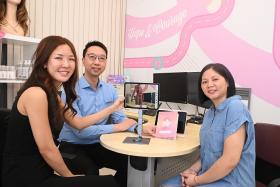Cancer survivor highlights importance of support group
Pink Ribbon Walk for breast cancer awareness took place today. A survivor highlights importance of a support group
When her company gave her the chance to get a free full body health screening, Madam Joyce Oon said: "Why not?"
That attitude saved her life.
That check-up in late 2011 resulted in a diagnosis of stage two breast cancer.
It was a shock for Madam Oon, a marketing manager at French corporation Schneider
"I was only 36," she told The New Paper.
"I had thought people who get breast cancer are 50... (I thought) I was way too young."
Madam Oon, now 40, had just taken part in the Pink Ribbon Walk that year.
Organised annually in October by the Breast Cancer Foundation (BCF), the walk takes place during the internationally recognised Breast Cancer Awareness Month.
This year's event is today, with a concert-carnival at 2pm. The walk itself starts at 5pm.
Despite being aware of breast cancer and its prevalence here, Madam Oon had been complacent.
She had no family history of cancer and had not felt any pain in her breasts that might have tipped her off.

Madam Oon said: "I had not gotten any MC for the past couple of years. I (thought I was) quite healthy."
She did not perform monthly breast self examinations and the 2cm growth remained undetected.
According to BCF, although breast cancer is most common in women aged 40 and above, women at any age are susceptible to it.
Breast cancer is the leading cancer found in Singaporean women, says the Health Promotion Board.
When Madam Oon was given the diagnosis by the doctor, she recalled her mother immediately breaking down at the news. She was stunned for a moment before crying as well.
Realising she needed to be with other breast cancer patients through this difficult period, she joined BCF's monthly support groups.
There, she heard other women share their trials.
"It was like sisters sharing their experiences. I felt very secure and comforted, knowing that I'm not alone," she said.
Even now, five years into remission, Madam Oon continues to go for these meetings.
"I want to pay it forward," she said.
She also gave a talk at an education session for human resources (HR) departments, detailing the necessity of supporting breast cancer survivors in the workplace.
Adamant about keeping her life as "normal" as possible, Madam Oon did not stop working while getting treated.
She recalled: "For my first round of chemotherapy, I stayed home for three days and was back to work on day four."
Her company played a big part in her recuperation. Madam Oon said her boss was understanding when she needed to leave work for treatment.
Meanwhile, her HR department took care of health insurance claims for her, giving Madam Oon ease of mind to focus on getting better.
Despite her positive attitude towards the illness, there were things that concerned her.
WORRIES
Single at the time, she would worry about whether her future partner would mind that she was a cancer survivor.
She also worried about the possibility of not being able to give birth.
But last year, Madam Oon got married to a colleague who had seen her go through treatments.
More good news - her doctor told her she was able to get pregnant.
Madam Oon now sees her diagnosis as a "wake-up call".
She knows the importance of breast self examinations and she regularly nudges those around her to be more careful about the possibility of having the illness.
Above all, it has taught her, a former workaholic, what to value in life.
As she said: "Last time, I used to work late nights and I would even bring work home.
"Now, if I have time, I would spend it with my family. What is more important than that?"
Checking for breast cancer
A breast self-examination can help reveal tumours at an earlier stage, and should be conducted once a month by women above 20.
Here are three ways to check:
1. Look for changes at the mirror

2. Feel for changes lying down

3. Feel for changes while in the shower

You should be looking out for:
1. Persistent lumps
2. Breast changing in shape or size
3. Dimpling or puckering of the skin
4. Retraction of the nipple
5. Discharge from the nipple
If you find any of these changes, do not panic. Most changes are the result of a non-cancerous cause, but
it is advisable to visit a doctor for a full check-up.

Get The New Paper on your phone with the free TNP app. Download from the Apple App Store or Google Play Store now


